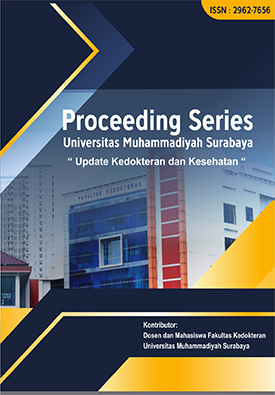Stunting pada Anak Bawah Tiga Tahun sebagai Tanda Bahaya (Red Flags) dalam Masa Pandemi COVID-19
Isi Artikel Utama
Abstrak
Abstract
Aware the COVID-19 pandemic period has made pre-young kids experience numerous impediments in addressing fundamental requirements because of multifactorial reasons for not exactly ideal development and advancement. The monetary emergency prior and then afterward the pandemic, the restrictions of assessment administrations when wiped out to the conclusion of routine essential wellbeing administrations. This happened practically 1 years 7 months until now and still ongoing. The effect felt by guardians straightforwardly and in a roundabout way about youngsters, particularly parts of not exactly ideal development require quick and concentrated treatment so the kid's development can be promptly sought after so it tends to be ideal. Stunting is Indonesia's challenge towards SDG'S 2020 which targets stunting rates to be smothered for brilliant ages to come. Red flags that lead to stunting should be recognized by parents so quick treatment can be completed on Indonesian kids.
Keywords: Stunting, COVID-19, Toddler, Malnutrition, Children
Rincian Artikel
Referensi
- Daftar Pustaka
- peta-sebaran-covid19 @ covid19.go.id [Internet]. Available from: https://covid19.go.id/peta-sebaran-covid19
- Centers for Disease Control and Preven-tion (CDC) Growth Charts, Available at www.cdc.gov/growthcharts/, Juli, 2021
- Dinas Kesehatan Kota Surabaya, 2021. Laporan Tahunan Dinas Kesehatan Kota Surabaya Tahun 2021. Surabaya: Dinas Kesehatan Kota Surabaya
- UNICEF. Nutrition – tackling the double burden of malnutrition in Indonesia. Available for: https://www.unicef.org/indonesia/nutrition
- Sumarto, Sudarno, Silva d, Indunil. Child malnutrition in Indonesia: can education, sanitation and healthcare augment the role of income? Available from: https://mpra.ub.uni-muenchen.de/66631/1/MPRA_paper_66631.pdf
- IDAI. Pentingnya pemantauan tumbuh kembang 1000 hari pertama kehidupan anak. Available from: http://www.idai.or.id/artikel/klinik/pengasuhan-anak/pentingnya-pemantauan-tumbuh-kembang-1000-hari-pertama-kehidupan-anak
- Johnson CP, Blasco PA. Infant growth and development. Pediatrics in Review. Available from: https://pedsinreview.aappublications.org/content/18/7/224#sec-23
- Haymond M, Kappelgaard AM, Czernichow P, Biller BMK, Takano K, Kiess W. Early recognition of growth abnormalities permitting early intervention. Acta Paediatr. 2013;102(8):787-796.
- Drever K. Is my child normal? milestones and red flags for referral. Available from: https://www.racgp.org.au/download/documents/AFP/2011/September/201109oberklaid.pdf
- Choo YY, Agarwal P, How CH, Yeleswarapu SP. Developmental delay: identification and management at primary care level. Singapore Med J. 2019;60(3):119-123.
- Devaera Y, Syaharutsa Dm, Jatmiko HK, Sjarif DR. Comparing compliance and efficacy of isocaloric oral nutritional supplementation using 1,5kcal/mL or 1 kcal/mL sip feeds in mildly to moderately malnourished Indonesian children: a randomized controlled trial. Pediatr Gastroenterol Hepatol Nutr. 2018;21(4):315-320.

